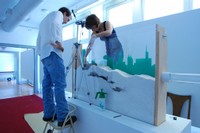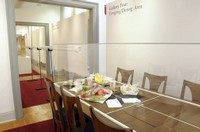
A Rutgers University–Camden artist concerned about the tiniest inhabitants of a fast food nation partnered with a behavioral ecologist to create an installation that features an enormous ant farm and McDonald’s Happy Meals as the sole feeding source.
Elizabeth Demaray, an assistant professor of fine arts at Rutgers–Camden, was commissioned to partake in “Trans-Evolution: Examining Bio Art,” three solo exhibitions currently on display at the CEPA Gallery in Buffalo, NY through Dec. 20. “Bio art” has informed Demaray’s own work for some time. A conceptual artist with a neuroscience background, the Rutgers–Camden artist’s previous works include knitting sweaters for plants, building alternative housing for hermit crabs, and creating listening stations for birds that play human music.

For the CEPA Gallery show, she proposed a large-scale installation that would allow viewers to see for themselves through myriad vantage points how 500 harvester ants might take to the colony’s first chain restaurant. While gallery attendees may be looking at ants, Demaray really designed the work for humans to reflect on how their own lifestyle might affect “biotopes,” environments that multiple species, not just humans, utilize.
“The impact of people on these shared spaces is enormous. An ant might be less than one-millionth the size of a human being, but ants taken collectively rival people as dominant organisms on the land. The soil they move circulates vast quantities of nutrients vital to the health of the land ecosystems. Is what we’re eating affecting not just our bodies, but ecosystems?” asks Demaray.
Thanks to a $10,000 artist honorarium supported by the Andy Warhol Foundation, Demaray’s site-specific work titled “Corpor Esurit (The body hungers), or we all deserve a break today,” now encompasses five gallery spaces. The ground-breaking work features a 7-foot-high by 8-foot-wide version of a child’s ant farm bedecked with the Buffalo skyline and a 20-foot Plexiglas tunnel that leads to an enclosed table set with four complete Happy Meals.
Demaray’s installation prompts the viewer to observe and record the ants’ vitality and behavior. Posted worksheets ask viewers to take note of what the ants are eating, how many ants they are seeing in a specific area, and to even sketch an ant. The exhibit also provides enlarged nutritional contents of the meals as well as background on biotopes.
As to what the ants like about the Happy Meal experience, Demaray says they’ve disregarded the popular plastic toy altogether and have made careful piles of seeds from the sesame seed buns.
“The ants do seem to really like the apple dippers and they love Sprite,” adds Demaray, who consulted with Christine Johnson, a behavioral ecologist at the American Museum of Natural History, to determine the most appropriate viewing habitat, food sources, and foraging site. At the close of the exhibit, the ants will be counted and returned to a normal diet.
Demaray’s fascination with perception in art originates from an undergraduate education in cognitive psychology and neuroscience at the University of California at Berkeley. She then studied art at the Skowhegan School of Painting and Sculpture in New York, before returning to UC-Berkeley to earn her MFA.
The recipient of the 2001-2002 National Studio Award at the New York Museum of Modern Art and a 2005 New York State Foundation for the Arts Fellow in sculpture, Demaray has shown her work in museums nationwide. She joined the Rutgers–Camden faculty in 2005. A northern California native, Demaray currently resides in Brooklyn.
- 30 -
Media Contact: Cathy K. Donovan
(856) 225-6627
E-mail: catkarm@camden.rutgers.edu